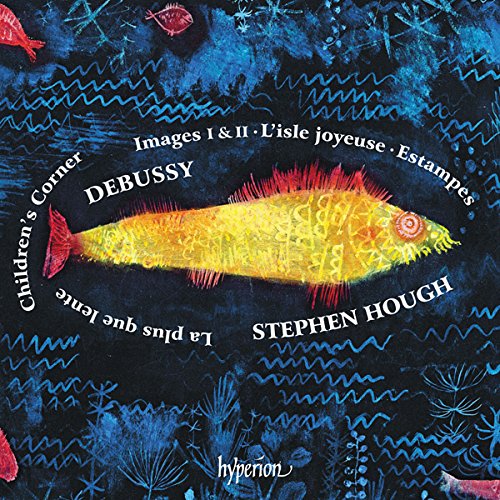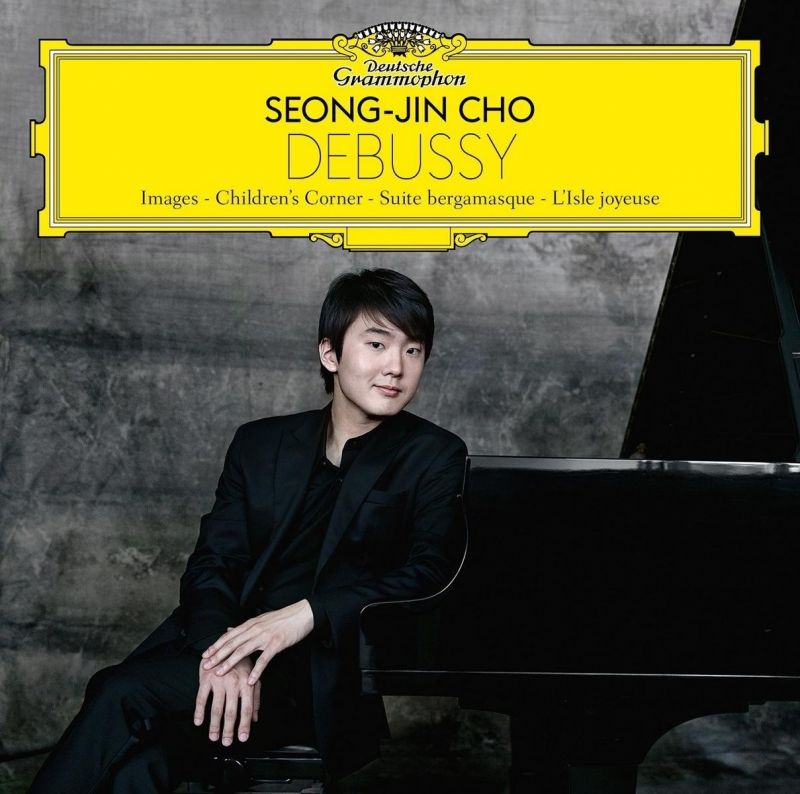DEBUSSY Piano Music (Hough; Cho)
View record and artist detailsRecord and Artist Details
Composer or Director: Claude Debussy, Stephen Hough
Genre:
Instrumental
Label: Hyperion
Magazine Review Date: 01/2018
Media Format: CD or Download
Media Runtime: 69
Mastering:
DDD
Catalogue Number: CDA68139

Tracks:
| Composition | Artist Credit |
|---|---|
| (3) Estampes |
Claude Debussy, Composer
Claude Debussy, Composer Stephen Hough, Composer |
| (6) Images |
Claude Debussy, Composer
Claude Debussy, Composer Stephen Hough, Composer |
| Children's Corner |
Claude Debussy, Composer
Claude Debussy, Composer Stephen Hough, Composer |
| (La) Plus que lente |
Claude Debussy, Composer
Claude Debussy, Composer Stephen Hough, Composer |
| (L') Isle joyeuse |
Claude Debussy, Composer
Claude Debussy, Composer Stephen Hough, Composer |
Composer or Director: Claude Debussy
Genre:
Instrumental
Label: Deutsche Grammophon
Magazine Review Date: 01/2018
Media Format: CD or Download
Media Runtime: 73
Mastering:
DDD
Catalogue Number: 479 8308GH

Tracks:
| Composition | Artist Credit |
|---|---|
| Children's Corner |
Claude Debussy, Composer
Claude Debussy, Composer Seong-Jin Cho, Piano |
| (6) Images |
Claude Debussy, Composer
Claude Debussy, Composer Seong-Jin Cho, Piano |
| (L') Isle joyeuse |
Claude Debussy, Composer
Claude Debussy, Composer Seong-Jin Cho, Piano |
| Suite bergamasque |
Claude Debussy, Composer
Claude Debussy, Composer Seong-Jin Cho, Piano |
Author: Harriet Smith
Where to start? Children’s Corner is always revealing. Stephen Hough’s ‘Doctor Gradus’ is full of sensitive phrasing and favours a relatively hazy sound world, compared to which Seong-Jin Cho has a degree more clarity and a striking sense of intimacy. How to pace ‘Jimbo’? Cho is a little slow, which can turn his lullaby into a dirge; no risk of that with Hough, who is positively flighty. Nelson Freire (Decca, 4/09) seems especially attuned to this particular elephant, to charmingly naive effect. The eponymous doll in the following Serenade is a knowing creature in Hough’s reading, while in ‘The snow is dancing’ he conjures a veiled landscape, whereas Cho opts for more clear-cut semiquavers at the outset. But turn to Osborne and be astounded by the way he finds as many shadings as there are Inuit words for snow. In the final number, the ‘Golliwog’s Cakewalk’, Cho goes at it with a will, finding plenty of charm too, but Hough really does seem to misjudge things here – it sounds arch and curiously under-energised. Turn to the wondrously colourful Freire or the anarchically punchy Osborne for the full effect.
Suite bergamasque suits Cho’s delicate pianism particularly well, and he brings charm to the ‘Prélude’ and a piquant exuberance to the ‘Menuet’, his upward-rushing scales suitably crystalline. He makes ‘Clair de lune’ individual without recourse to exaggeration and the final ‘Passepied’ wraps things up with a winsome delicacy.
Hough begins his disc with the Estampes, a vivid reminder that Debussy loved art as much as music, and Hough similarly paints as well as plays. His ‘Pagodes’ sets the scene with just the right degree of blurring of the lines, motifs emerging and then receding once more, all combining to ethereal effect. In the closing ‘Jardins’ his pacing is spot-on and we get hints of the obsessive qualities that prefigure the Études, which give it a pleasing edginess. But I was less convinced by ‘La soirée dans Grenade’, which, though beautifully finished, sounds just too languorous, lacking a certain earthiness that Bavouzet conveys so effortlessly.
And so to the Images. Hough seems to me most successful in the slower numbers – the opening ‘Reflets dans l’eau’ is coloured with great subtlety and refinement. In the last of Book 1, ‘Mouvement’, Hough is pristine but a little slow for my taste, especially compared to Bavouzet, who finds tremendous clarity but also fullness at the climax around the minute mark. Cho here is a little on the hazy side though I much like his gradations of softness as he ascends to the top of the keyboard at the close of the piece. ‘Cloches à travers les feuilles’ is another interesting point of comparison: the interplay of the lines is limpid in Cho’s hands, Hough opting for a more haloed effect – preference will be down to personal taste. But then sample Osborne and you find more risk-taking in the quietness, an unmistakable sense of dolour that pierces the heart. In the following ‘Et la lune’, again it’s Osborne who really gets to the heart of the matter, leaving the readings by Hough and Cho seeming slightly workaday.
I have reservations when it comes to ‘Poissons d’or’ too. Here Cho and Hough seem too slow: the inspiration may have been a Japanese lacquer plaque hanging on the composer’s wall but these are sluggish, slightly dull golden fishes, where they should glisten. By comparison, Osborne brings them to life, glinting and wriggling; so does Bavouzet, to gleeful effect.
Finally to L’isle joyeuse. Again I find Hough a little bit steady – every phrase has clearly been considered but it doesn’t propel you forwards as Cho does and both are relatively pale affairs compared to the exultant reading of Bavouzet, who brings to it a Lisztian brilliance filtered through a French lens.
Discover the world's largest classical music catalogue with Presto Music.

Gramophone Digital Club
- Digital Edition
- Digital Archive
- Reviews Database
- Full website access
From £8.75 / month
Subscribe
Gramophone Full Club
- Print Edition
- Digital Edition
- Digital Archive
- Reviews Database
- Full website access
From £11.00 / month
Subscribe
If you are a library, university or other organisation that would be interested in an institutional subscription to Gramophone please click here for further information.




